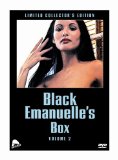Severin unleashes three more entries from Italy’s long-running sexploitation saga, and the result is another fascinating collection. The quality of the movies themselves up and down, but the good stuff is very good, and the collective result is something that is completely fascinating. Exploitation fans should be over the moon.
I’ve already gone on at length about Black Emmanuelle/White Emmanuelle (1976) elsewhere, so I won’t rehash everything again. Briefly, though, the set-up has Laura Gemser as Emanuelle (let’s stick to the single “m” version to avoid confusion with Sylvia Kristel), here a model instead of a journalist, arriving with SOB photographer boyfriend at the palatial home of some friends in Egypt. Much aristocratic ennui ensues, until Laure (Annie Belle) arrives to tear down everyone’s comfortable illusions. The most nicely shot and intelligently scripted of the films, there is something absolutely mesmerizing about the display of decadent self-loathing proposed here. Writer/director Brunello Rondi’s effort is emphatically a high point of the series, and invites repeated viewings.
Black Emanuelle 2 (also 1976), sees Sharon Lesley take over the part. Once again a model, Emanuelle is suffering from amnesia and false memories, and her psychiatrist (Angelo Infanti) struggles to help her while beset by his equally troubled niece and a wife (Dagmar Lassander) jealous of his work. Largely set in New York, the film lacks much (thought not all) of the exotic travelogue beauty of the other entries, and the presence of the ethereal Gemser is sorely missed. There are some rather neat games with reality and illusion played out here, though, and the Italian recreation of Harlem is hilarious.
Gemser, thankfully, is back for Emanuelle and the White Slave Trade (1978), which is the last entry she and director Joe D’Amato did together. The travelogue is back with a vengeance here, and the extremely meandering plot eventually sees Emanuelle, finally a journalist again, infiltrating a brutal prostitution ring that runs a high-end, secretive bordello for the well-heeled. The sex is approached with a rather nasty sniggering attitude, and the film does feel a bit like the sort of thing that is being critiqued in Rondi’s film. Not a patch on D’Amato’s Emanuelle Around the World, it still is just bizarre enough to keep one watching.
Audio
All three films are mono, with Black Emanuelle 2 and White Slave Trade sporting the English dubs, which certainly makes sense for the former’s NYC setting, even if everything else about the production screams Italian. The audio for White Slave Trade has some problems, with words dropping out completely a few times. Both English and Italian options are available for Black/White, and the default Italian option is definitely the way to go here. Though just as post-synched, the lip movements match up better, and the vocal performances are much stronger.
Video
D’Amato’s film is the weakest of the bunch on this score, with noticeable grain and colours that are rather washed out, leeching the settings of much of there pictorial beauty. This is very much a problem of the print, not the transfer, and, factoring in budget and D’Amato himself, might well be something no release could overcome. Rondi’s film looks much better, with nice, strong colours, but there are some very soft shots here too. Black Emanuelle 2, finds a sort of middle ground. It’s not the best-looking film in and of itself, but the print holds up well.
Special Features
“Black Velvet” features on-screen interviews with Al Cliver, who plays the ridiculous holy man in Black/White, and audio interviews with Annie Belle and Laura Gemser (and I can’t believe that the presence of the latter on the interview track isn’t trumpeted on the case). Black Emanuelle 2 has “Diva 70,” and interview with Dagmar Lassander, which jumps around a bit from subject to subject, but is also a real eye-opener about working conditions for actresses in Italy in the 1970s. White Slave Trade has a vintage interview with D’Amato. It’s an interesting to see the man holding forth over a kitchen table, passing the beer bottles with his interviewers, but I do wish said interviewers had asked him about more than just his hardcore efforts. The big treat here is another audio CD, this one featuring the soundtracks to White Slave Trade, Emanuelle in America, and Emanuelle and the Last Cannibals (AKA Trap Them and Kill Them). White Slave Trade’s opening credits song “Run Cheetah Run” is a trash/camp classic of the first order. All three discs also feature their respective theatrical trailers.
Closing Thoughts
Releasing these films as a box set is, I think, a terrific move, as watching them in quick succession is the most bizarre and delightful plunge into a lost but weirdly compelling form of filmmaking. Keep ‘em coming!





